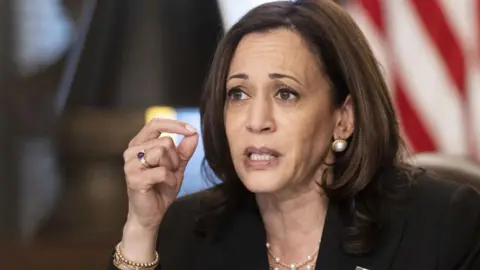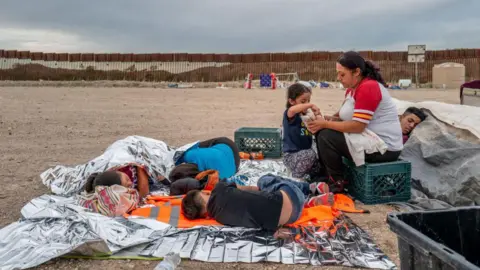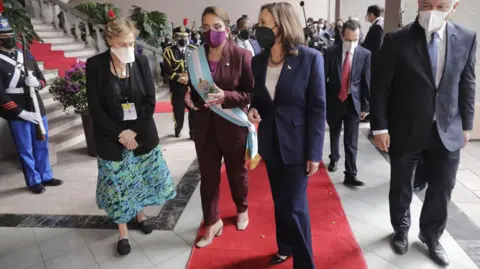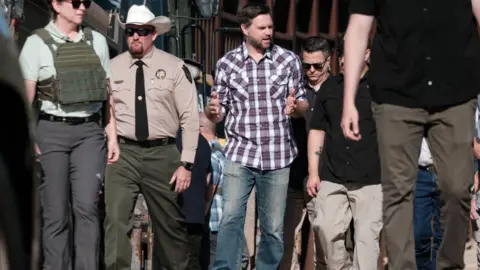
 Getty Images
Getty ImagesFrom its opening line, Donald Trump’s first TV ad harshly attacking his rival Kamala Harris took aim at what his campaign believes is her greatest weakness: immigration.
“This is America’s border czar,” said a narrator, over images of the dancing vice president, “and she has failed us.”
The following are statistics that illustrate what the Trump campaign says has happened under the presidency of Ms. Harris, whom President Joe Biden tasked with managing the border crisis soon after taking office.
The figures in the video ranged from 10 million illegal border crossings to 250,000 fentanyl-related overdose deaths.
The voice concluded: “Kamala Harris: failure, weakness, dangerously liberal.”
Harris’s campaign responded that the former president was running based on his “signature lies.”
Not surprisingly, the Trump campaign launched its first major attack on Harris, calling her a “failed border czar,” blaming her for the high number of illegal immigrants at the southern border of the United States.
Americans have repeatedly said in polls this year that immigration is one of their country’s top issues, and that will be on their minds as they vote for the next U.S. president in November.
Since that first announcement, Trump and his running mate J.D. Vance have repeatedly labeled Harris a “failed border czar,” and associated her with stark images of people struggling across the Rio Grande or ducking under barbed wire to enter the United States.
His critics argue that he should have found a way to address the issue over the past four years.
But “border czar” is a contested term. Allies and former officials who worked with the vice president say she was not given responsibility for policing the border.
“That was never the position,” said Ricardo Zuniga, former deputy assistant secretary of state for Western Hemisphere affairs.
“She knew from the beginning, as did the entire U.S. government, that it was about addressing migration at the source.”

 Getty Images
Getty ImagesIn early 2021, President Biden gave Ms. Harris the unenviable task of addressing the “root causes” of Central American immigration.
At the time, people were fleeing a perfect storm of gang violence, economic ruin and environmental disaster in a region called the Northern Triangle, made up of Guatemala, Honduras and El Salvador.
Speaking to migrants passing through Mexico, it was clear that most were from Honduras, where, they said, a brutal “narco-dictatorship” was in power and wages were as low as five dollars a day.
While the ultimate goal of Harris’s role was to reduce the number of people arriving at the U.S. border, Biden never used the words “border czar” in announcing her nomination.
“He is the best qualified person to lead our efforts with Mexico and the Northern Triangle to stem the movement of so many people to our southern border,” Biden said at the time.
However, many people have come to see the job as all-encompassing. Several media organizations, including the BBC, have described Harris as a “czar” in the news.
Some commentators in Central America and Mexico questioned her qualifications, given that Harris had no prior experience in Latin American affairs.

 Getty Images
Getty ImagesWhether I was a tsar or not, that job was arduous and thankless task.
To successfully manage decades of underinvestment and the region’s deep economic and political conflicts would require enormous amounts of money, along with goodwill and cross-party cooperation. All of which is in woefully short supply in Washington, especially when it comes to immigration.
“The idea that a U.S. administration can change 500 years of Central American history in a four-year period is ridiculous,” says Ricardo Zúniga.
As a former senior U.S. diplomat in the Northern Triangle, he argues that the Biden administration has indeed made progress in solving Central America’s problems.
It highlights Ms Harris’s help in raising $5bn (£3.9bn) from the private sector for job creation and entrepreneurship in the region. Several former members of her team describe how she personally called CEOs, convincing them to invest funds.
During her visit to Guatemala and Mexico in June 2021, I saw Ms. Harris trying to put on a softer face after four years of harsh rhetoric from Donald Trump. She said she appreciated that people were fleeing “hunger, hurricanes and a pandemic,” and went on to establish a task force on corruption in Central America.
That journey, however, is best remembered for its stark message to all potential migrants: “Don’t come. If you come to our border, you will be turned away.”
Millions ignored his warning. Nearly two years later, in December 2023, Customs and Border Protection (CBP) officers encountered 300,000 illegal immigrants at the southern border of the United States.
Many of those who have governed along the border in recent years do not look favorably on Kamala Harris and her work in Central America.
“Whatever he was doing diplomatically in other countries, I wouldn’t call it very effective based on what we’ve seen here at the border,” says Douglas Nicholls, the Republican mayor of Yuma, Arizona.
“We had record numbers of people, numbers that far exceeded anything we had ever seen before, including more than three times the population of my city in one year. Those were scary numbers.”
The vice president is a “legitimate” target on the issue, which he says is not “a made-up excuse to gain grassroots support.”
“We should have addressed this issue much earlier than we did,” says Mayor Nicholls.
Others argue that the funds raised by Ms. Harris have had only a minimal impact on the main incentive that drives people north: getting paid in U.S. dollars.
Ricardo Barrientos, director of the Central American Institute of Fiscal Studies, said U.S. private sector investment pales in comparison to the remittances Central American migrants send home: $37 billion last year alone.
“It’s very small compared to the scale of the challenge. Some would say, ‘too little, too late,'” he said.
But Katie Tobin, who worked for the White House on immigration, says Harris’s work has been deliberately “misunderstood and painted in a bad light.”
Ms. Harris deserves credit for “some good news” in Central America, he says. He points to statistics showing a 72 percent drop in immigration from Central America alone between March 2021, when Ms. Harris took office, and June 2024.

 Getty Images
Getty ImagesUltimately, the view of Ms. Harris’s record may simply divide along party lines.
In recent months, the overall number of illegal migrants has plummeted.
That’s partly due to an executive order issued by President Biden that allows migrants in the U.S. illegally to be deported without processing their asylum claims. There are also more legal pathways for potential migrants to enter the U.S.
Ms. Harris’s defense mainly points to Mr. Trump’s resistance to getting Congress to pass a bipartisan deal on immigration reform.
Lawmakers reached the deal in February after a tense dispute, with Democrats giving up significant ground to Republicans. Republican leaders then blocked it at Trump’s request, reportedly because he didn’t want to hand a victory to the Biden administration.
“It was Trump himself who, for overtly political reasons, undermined an agreement that would have helped stabilize the border,” Mr. Zúniga says. “So the Trump campaign is kind of on their side of things.”
Yuma Mayor Nicholls is unfazed by this defense, saying, “I think this is a very short-term memory.”
He recalls reaching out to the Trump White House at a time of crisis. He was invited to discuss immigration directly with the president and the secretary of Homeland Security in a meeting where he was given more resources.
Three months later, he says, “we were out of the crisis.”
“This is effective leadership at the border,” he added.
However, Ms. Tobin argues that the Harris campaign should talk about it more.
“When there’s a vacuum and the vice president isn’t talking about immigration, it creates an opportunity for Republicans to fill the airwaves with misinformation.”
Harris’s campaign responded to Trump’s first ad with some of its own messaging.
The first focused on Trump’s opposition to the immigration deal, accusing him of trying to prevent her from fixing the “broken” immigration system.
A more recent article spotlighted her work before the Biden administration, arguing that as California attorney general, Harris prosecuted drug cartels and gangs and, as president, would crack down on fentanyl and human trafficking.
It remains to be seen whether this new position will be enough to shake off the label of “failed border czar,” as Republicans will no doubt continue to hammer that image into Election Day.







